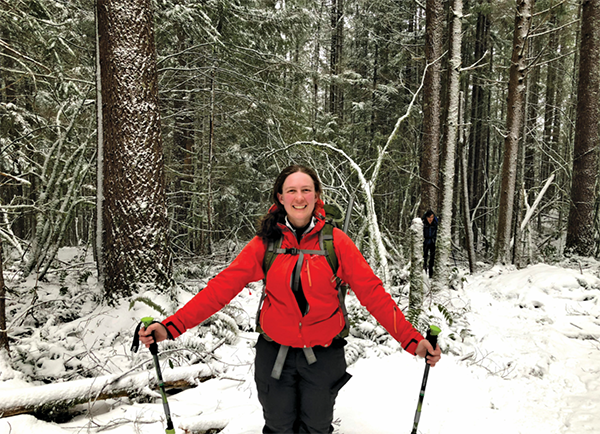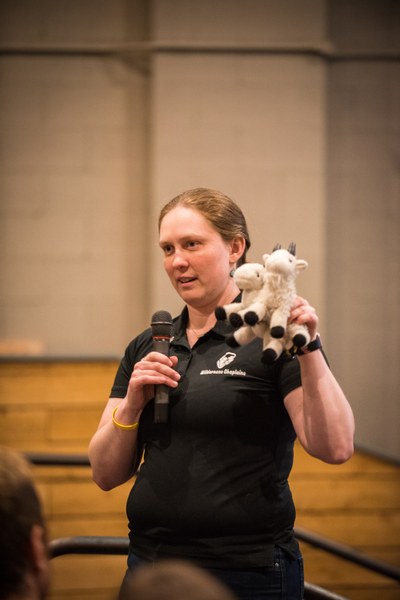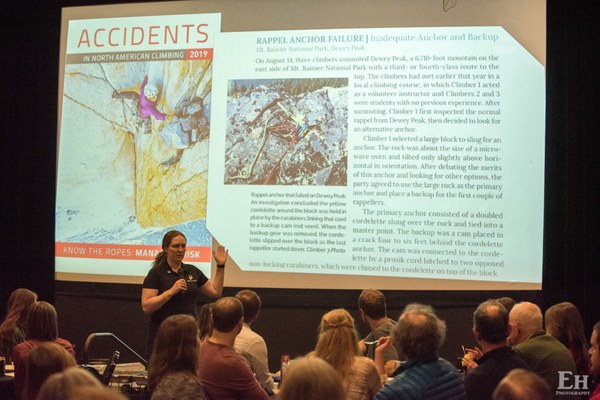
Following the climbing death of a close friend on a non-Mountaineers climb in 2018, Katjarina (Katja) Hurt and a group of climbers came together to uncover the thinking errors that culminated in their friend’s death. Their work led Katja to create Breaking the Halo: Empowering Students in Outdoor Education, a course in understanding how leaders’ decisions often go unquestioned due to their expert status, also referred to as the “halo effect.”
Katja’s goal with this course is to explain how to recognize assumptions and help students confront heuristic traps that can lead to dangerous situations in the outdoors. She believes it could make a large difference in our safety if leaders and students are taught about halos and how to confront them. “I teach about the halo effect in honor of [Stephen’s] memory. I tell his story and share these lessons as much as I can because I believe he would want me to. He was the kind of man who would give his life for another in a heartbeat, and if it can make a difference and save even one life by changing some of the culture around these types of accidents, then it’s worth it.”
Katja has been on Snoqualmie Pass’s ski patrol for over 14 years, is a fourth generation Mountaineer, and was recently appointed the Olympia Branch’s Leadership Committee Chair. Over the past three years, Katja has presented Breaking the Halo for numerous Mountaineers scrambling, climbing, and leadership development programs, as well as for executive leadership teams at various government and local agencies.
We met with Katja to gain a better understanding of the halo effect and how we can avoid heuristic traps.
Can you describe the halo effect for those who may not be familiar?
American psychologist Edward Thorndike was the first to document how a person’s first impression can place a “halo” of goodness around them. Then Ian McCammon with the National Outdoor Leadership School wrote about heuristic traps. McCammon found that in outdoor groups, a “halo” is typically placed over the leader or the most experienced person. That person is interpreted to be all-knowing and flawless. This leads the group to concede their decision-making to the person upon which the halo is placed. The group becomes hesitant to call attention to the faults they may notice. Instead, they completely defer to the leader. This is dangerous. A halo is a red flag – an indicator of complacency.
What is the connection between assumptions and a halo?
We know that assumptions are not always bad. Some assumptions are natural, it’s pattern recognition. The assumptions where halos come into play are when we’re shortcutting our rational thinking. We jump from point A to point Z, thinking everything’s going to flow in between. Halo effects derive from assumptions. When we’re blind to the assumption, that’s where the halos begin to show.
Katja presenting Breaking the Halo in Richland, WA. Photo
by Evan Halladay.
What are some best practices for dismantling halos?
Start paying attention to overconfidence. Watch your attitude and let that be your guide. Aim to have a partner who can challenge you and give you feedback. I value the friends in my life who disagree with me, who will call me out and question me. These are amazing people to have in my life because they say what I need to hear, not necessarily what I want to hear. People that can have those difficult conversations with you and provide feedback are valuable for breaking halos.
Try not to fall into the traps of complacency. Quiz yourself, do a drill to see if you really do have those skills down. Have a checklist and use it regularly to review all the steps – it’s easy to miss a step when you’ve done it a thousand times.
Be a lifelong learner. I graduated from the Basic Climbing Course in 2018. There was one year the climbing instructors asked graduated students to return and lead the Glacier Skills workshop. I returned as a student instead. I had to admit that I was not ready to be a leader as I didn’t remember how to do everything. I was willing to humble myself and grow more as a student. I was intentionally breaking a halo in my life whilst modeling that behavior for others.
Katja presenting Breaking the Halo in Richland, WA. Photo
by Evan Halladay.
How can we support others who are standing their ground to break a halo?
I love breaking down decision points for people before, during, and after an event. If there’s a halo happening, there was a time before and there will be a time after the halo. The best thing to do is prevention. Beforehand, empower your group to call timeouts. Specify how leaders and instructors are not infallible.
After breaking the halo, do a follow-up. Debrief about lessons learned. During the moment when someone is standing their ground to break a halo, tensions can be high. That’s also when there can be a lot of risk. When someone breaks a halo, they may be raising their hand during class to share their different view or they may be on a ski hill saying not to cross that slope. It’s important for the person receiving the feedback to stop and listen, rather than disregard and push forward. Take the time to acknowledge the person breaking the halo and train yourself to listen, even if you don’t agree with the feedback. It shouldn’t be a hasty response to silence the individual.
Be an advocate for the voice that no one wants to hear. When someone has the courage to speak up, it’s important to give them the chance to speak their piece. You’re listening to another perspective and now have a chance to clarify a possible misunderstanding.
Anything else?
The Mountaineers have been so supportive of my story. It’s amazing how much interest there is in embracing this presentation and having these conversations around halos. After Stephen’s death, many people assumed I was going to blame so-and-so. I like to think it’s been a healing process to recognize the tragedy. Being invited by The Mountaineers to talk about halos the year after Stephen’s death was so empowering. It was beautiful to see how The Mountaineers community was willing to trust me and that Stephen’s loss was not going to be swept under the rug. To recognize that it was not just a misfortune or a statistic, it was real, and we could come through it together.
Learn more about Katja’s mission to break every halo and empower students in outdoor education at breakeveryhalo.com. Katja is also the director of the nonprofit Wilderness Chaplains, an organization dedicated to bringing nondenominational crisis intervention to wilderness first responders and the communities they serve. Learn about their work at wildernesschaplains.com, or read about her work as a wilderness chaplain at mountaineers.org/chaplain
This article originally appeared in our Winter 2022 issue of Mountaineer Magazine. To view the original article in magazine form and read more stories from our publication, visit our magazine archive.
 Michelle Song
Michelle Song

